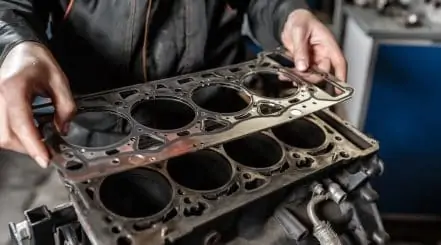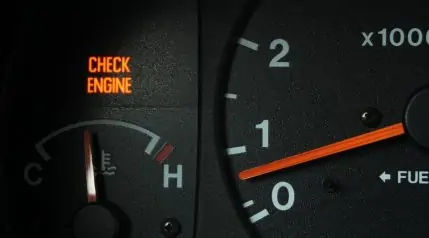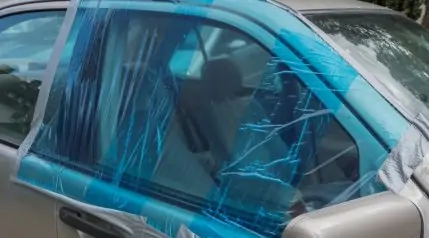
All drivers will sooner or later have to deal with a flat tire.
Sometimes it’s very obvious — it pops, takes you by surprise, and you can hear and feel the effect straight away. Other times, you may get a punctured tire and a slow leak, for which you’ll need to check the tire pressure.
The end result is always the same, though — we end up driving on a flat tire. This can be a scary situation to be in, and is very dangerous to our lives, our passengers’ lives, and those of whoever else happens to be on the road around us at the time.
While many of us know how to change a tire, or even treat one with tire sealant, we aren’t sure what to do if we have to drive on one that has lost its air, which may be necessary if we don’t carry spare tires.
So, what should you do when faced with no other option but to drive on a flat tire? We’re here to tell you everything you need to know to stay safe and avoid any costly damage to your car.
In the following sections, we’ll explain why driving on a flat tire can be dangerous, what specific steps you should take whenever your tire goes flat, and what tips to keep in mind for handling specific situations based on where this happens.
Contents (Jump to Topic)
Key Takeaways
Check Tire Pressure – The number one rule of tire maintenance is to check your tire pressure on a regular basis. This will help you identify slow leaks and anticipate tire trouble.
Preventative Measures – Tire rotations, sticking to the maximum load rating (aka “tire load limit”), and checking tread depth are all ways to avoid a tire blowout.
Carefully Does It – Driving on flat tires can be done, but only with the utmost care and for the shortest distance possible.
What Are the Risks Involved in Driving on a Flat Tire?
Before ever attempting to drive on a tire, you should familiarize yourself with the dangers you could face – and those you could subject other people in the car with you (or on the road around you at the time) to.
First things first, the most obvious of those is that low tire pressure, a flat, or other tire damage can cause a loss of vehicle control. If you do lose control, it can easily lead to an accident. The consequence can be an injury, damage to your suspension and steering system, and harming others on the road. Depending on how bad it is, it could also lead to fatalities.
Driving on a deflated tire can also cause internal damage to the tire structure. This means that you’ll have to replace it, not just fix it. If you cover long distances, other parts of your car may also suffer as well.
Generally, when driving on a flat tire, you run the risk of damaging the following parts: brake lines, calipers, rotors, wheels, fenders, or suspension parts. While replacing just the tire is not overly costly, these damages may add up to thousands of dollars.
What Can You Do if You Are Forced to Drive on a Flat Tire?
Obviously, the best thing would be for you to not drive on a flat tire, but that’s not always possible.
In some situations, you might not have any alternatives but to keep going. For example, if you’re in heavy traffic, or there’s no place available to safely pull over immediately, you’ll have to keep going until you can safely stop somewhere.
And even if you can pull over somewhere, do you know exactly what you need to do? You might know how to change your tire theoretically, but not in practice. So, you don’t want to do this unless you actually know what you’re doing.
Now, let’s take a look at a series of personal and vehicle safety pointers that can help in case your only choice is to keep driving on a flat tire until you get somewhere you can safely stop your car.
- Stay calm. Make sure to stay calm and maintain control over your vehicle.
- Pull over immediately. As soon as it is safe for you to stop the car, pull over, and check the car. Assess the damage, then decide whether to keep going or not.
- Drive slowly. If you decide to keep on driving to get help, proceed slowly and cautiously. The maximum speed you should reach is 20 mph. Driving fast can cause further damage to many of your car parts.
- Turn on your car’s hazard lights (if it’s legal). This signals you’re having car trouble to other drivers. If you’re driving much slower than other vehicles, hazard lights will make you more visible. Make sure it’s allowed in the state you’re driving in. In many states, it’s illegal to drive with hazard lights on.
- Avoid turning. Try to drive straight ahead if possible. Making turns while driving on a flat can cause damage to the rims.
- Drive on a flat surface. Hills, potholes, or rough roads are to be avoided as much as possible.
- Do not drive excessive distances. The sooner you can pull over to put on the spare tire if you’re able, the better. If it’s only a very short distance you’re driving, you’ll be safer than diving on a flat for long distances. As a rule of thumb, you shouldn’t drive for any distance that exceeds 70 miles.
- Know your tires. Check your tire specifications. Some manufacturers will specify how far and at what speed you can drive on a flat tire.
- Get to a service station. Let’s say you don’t have a spare, you don’t know how to change one, or you can’t drive on your spare for any longer. In such a case, the best thing you can do is find the nearest gas station.
- Call for help. If you’re too far from a gas station, and you have a charged phone, call for help. Emergency vehicles will come to tow your car. Some of these services will even offer a tire replacement for you on the spot.
- Consider purchasing run-flat tires. These are specially designed to allow safe, continuous driving even on a flat. They act as a cushion even if completely flat, preventing damage to the rims and other parts of your car. They do wear out sooner than regular tires, though.
Extra Tips for Different Scenarios
The general tips mentioned above are great to follow if your car tire is flat.
Now, we’ll take a look at different scenarios that might require some further advice. These include country and city driving, roads and highways, as well as adverse weather, visibility, and safety conditions.
Country Roads
Let’s say you’re driving down a country road when your tire pressure monitoring system tells you you have a flat or you notice the flat by yourself.
Traffic will probably not be an issue, so it’s better to pull over on the side of the road immediately. Remember to turn on your car’s hazard lights to be visible to passing vehicles.
At this point, either change the tire yourself or ask for someone’s help. If it’s an isolated place, the nearest gas station might be too far to reach.
Highways
In this case, traffic and speed will most likely be your biggest challenges and safety concerns.
Slow down and safely reach the emergency lane to stop, and make sure you use your turn signals.
The positive thing about this is that you’ll likely be close to a gas station, and possibly a call box from which you can call a tow truck. If there is no emergency lane, follow the tips above until you reach an exit.
City Roads
Again, city roads might be very busy, but at least traffic will be slower.
Pull over, and make sure your car is not in the way of other vehicles. In a city, getting help or to a tire repair shop should not be all that difficult.
Poor Weather Conditions
If it’s raining, snowing, or foggy, visibility will not be optimal. This can be very dangerous, as other drivers might not see your car until it’s too late to avoid it.
If you must stop, make sure you pull over in a safe place and turn your hazard lights on.
If a safe spot isn’t available for you to pull your car over in, get yourself and any passengers out of the vehicle as soon as you have a safe opportunity to do so. Move away from the car and find a safe place to wait for help.
In the unlikely event of a collision, it’s better to think of people’s safety before the vehicle’s.
Night Time
Visibility will be your biggest obstacle at night, especially if you’re not on a well-lit road.
The same tips mentioned above for poor weather conditions apply for night-time driving. People’s safety is always the top priority!
Unsafe Areas
If you get a flat in an unsafe area, stopping in dangerous territory is usually not the best solution.
For example, if you are driving in a high-crime neighborhood in a big city, it might be better for you to keep driving slowly until you reach a safer area where you can get help – while keeping yourself (and your passengers) safe.
Final Thoughts
In any emergency, the most important thing is to remain calm. Common sense will go a long way in helping you decide what steps to take to make the best out of a difficult situation.
A flat or damaged tire is usually not a dire situation, but it does require a well-thought-out plan of action.
If you’re not well prepared beforehand and don’t know what to do if ever faced with having to drive on a flat, you can get yourself (and others) into some serious trouble.
We’ve gone through all the general steps, and have also mentioned some important tips for specific situations. Now that you made it this far into reading this article, if you ever do get a flat and have to continue driving, you know exactly what you need to do!
Have you ever had to drive on a flat? Got any interesting stories to tell, or lessons you’ve learned that could possibly prove very beneficial for other readers? Let us know what happened in the comments!
Also, feel free to ask us about anything we might have not covered if you have any additional questions – we’ll be sure to answer as many of your questions as we possibly can.
Till then, drive safely!




